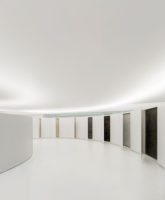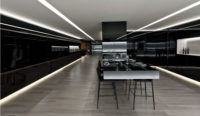Located on a third of an acre facing a golf course outside Valencia, Spain, the Balint House proves that the most unexpected designs can arise from confronting obstacles. In this case, the problem was a municipal ordinance that limited new houses to one story and a sloping roof. Seeking to squeeze more square footage out of the small site for his clients, a couple with two children, local architect Fran Silvestre came up with the idea of an arched roof, rising high enough to include a full 'attic' floor of bedrooms while still satisfying code. 'We rounded off the shape a little, and everything started coming together,' says Silvestre.
The resulting elliptical structure, with a swooping roof and deep cantilevers over its two symmetrical ends'one facing the street, the other overlooking a pool terrace and the golf greens'could not be more elegant or succinct. It is a solution to which nothing can be added or taken away. The cantilevers protect the large glazed openings below them from the strong Mediterranean sun and provide balconies for the bedrooms, while the curving walls pull the house away from the side yards so it won't crowd the lot. 'It's a kind of streamlining,' Silvestre suggests.
Inside, the ground-floor living spaces are completely unencumbered by interior walls, opening views straight through the house. Silvestre articulates the different living zones by organizing them around a central double-height stair hall, creating a sense of interior depth and vertical release in the otherwise ethereal space. The hall rises to a rectangular skylight at the highest point of the roof. Gray smoked-glass balustrades on the stairs and the upper-level corridor around the opening contrast with the ground floor's white finishes. Sunlight penetrates the skylight to cast a brilliant, shifting rectangle of light across bleached-wood floors, while the glass balustrades catch glittering reflections of outdoor views.
The only interior divider on the ground floor is a long cabinet that stops just below the ceiling, separating the kitchen from the hall. With the clean lines of the kitchen's island and classic pieces of modern furniture such as Arne Jacobsen's Egg Chair, selected by interior designer Andr's Alfaro Hofmann, the interiors inevitably draw comparisons to the open living spaces of Mies van der Rohe's Farnsworth House or Philip Johnson's Glass House. But Silvestre adds the vertical thrust of the stair hall to his fluid, horizontal spaces and solves the privacy problems of sleeping areas with a conventional bedroom floor upstairs. A full basement includes guest rooms that overlook a sunken light court facing a side yard. The resulting design is uncompromisingly direct and minimal, bringing together in one neat package the familiar elements of the single-family house.
The project required some structural sleight-of-hand to arrive at this simplicity of line. The entire house stands on four columns, which rise two stories through the short lateral walls to support the roof's concrete vault. The bedroom floor is suspended from this vault via high-strength concrete panels hidden in the partitions. By routing plumbing and other services through the building's thick side walls, Silvestre could leave the ground floor ceiling completely free of interruptions. To counter the horizontal thrust of the vault, a concrete tension ring girdles the building at the level of the balcony balustrades. The two overhangs are counterbalances, extending up to 18 feet.
Silvestre studied various finishes for the curved exterior walls and roof, including stucco, ceramic tile, and stone, before selecting man-made solid surface for its smoothness, hidden joints, and resistance to water. Though most often used in kitchen counter tops, it is certified for exterior applications in Spain. The material was mounted directly on an aluminum subframe without backing, as its high bauxite content makes it compatible with aluminum's thermal expansion rates. Panels of it were curved slightly at the factory without thermal forming or molds, and clipped onto the aluminum to achieve their final curvature.
Silvestre points out that, despite the unusual form of the house, its surfaces curve in only one direction, not the two a dome or computer mouse does. 'We built the model for the design using only two pieces of cardboard,' says the architect. 'I've found that if we can't build what we're thinking about in a model, it will be very difficult to build in reality.'
With the Balint House, Silvestre breaks from the rectilinear lines of previous works, such as his Atrium House and the Vegamar Wine Boutique, and puts his daring structural innovations center stage. He gives much of the credit for this audacity to his client, a dealer in building products, who chose the design over two more conventional schemes. 'He's a self-made man who wanted an identity of his own,' says Silvestre. 'He told us he liked this design because he'd never seen anything like it.' With its fluid white forms of no identifiable material and a wing-shaped pool that wraps around the terrace like a spreading wave, the house has the relaxed feel of a luxurious yacht docked by a greensward.
|
Balint House by Fran Silvestre Arquitectos (www.fransilvestrearquitectos.com) |
Size: 5,400 square feet
Construction Cost: Withheld
Completion Date: August 2014
PeopleClient: Florin Bortos Balint ( Globalint SL) Owner: Florin Bortos Balint ( Globalint SL) Architect Personnel in architect's firm who should receive special credit: Interior designer: Engineer: Structural engineer: David Gallardo | UPV Consultant(s): COLLABORATORS COMPANIES Photographer(s): Diego Opazo (0034 616074011) |
ProductsExterior cladding Roofing Windows Glazing Insulated-panel or plastic glazing: Other: Locksmithing: Laminated tempered glass, black Doors Interior finishes Paints and stains: Wall coverings: Special surfacing: Floor and wall tile: Furnishings Tables: Other furniture: Lighting |













Post a comment to this article
Report Abusive Comment